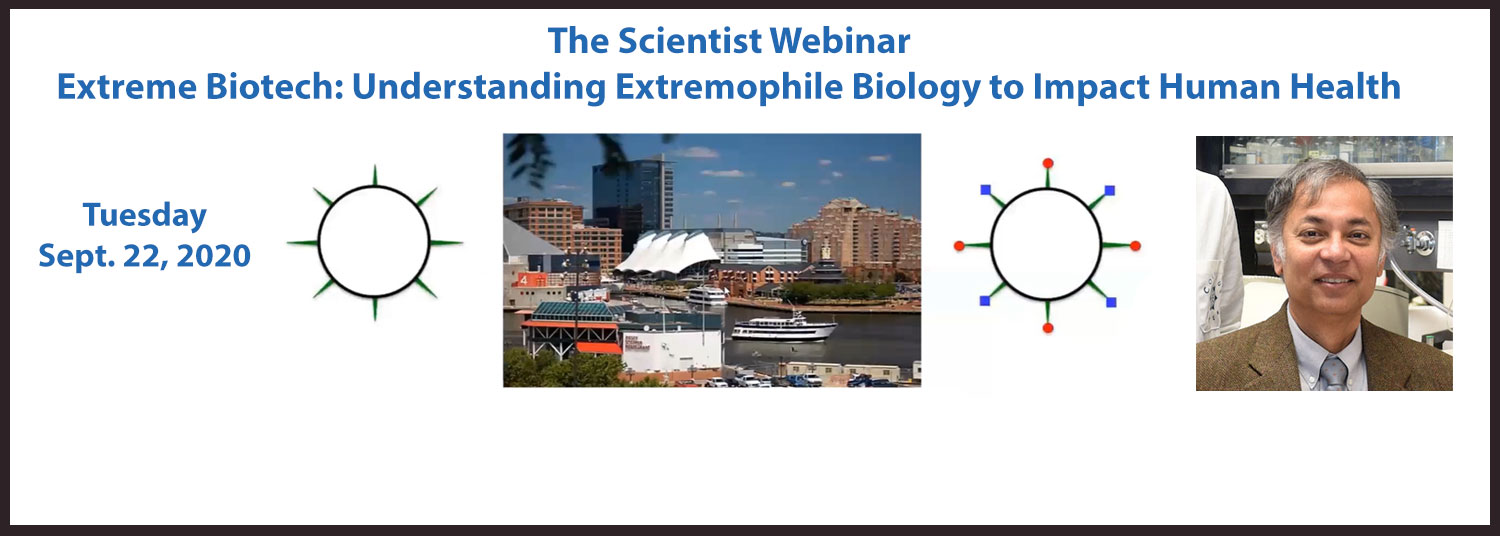DasSarma Lab Group
Summary of Research Interests
The DasSarma laboratory was established in 1986, soon after the discovery of the Archaea. Since then, we have been studying these novel microbes and their mechanisms of adaptation to challenging habitats, including extreme environments and the human microbiome. We use a combination of genetics, genomics, bioinformatics, transcriptomics, and other approaches to address problems of fundamental importance. Our favorite model organism is Halobacterium sp. NRC-1, a salt-loving, radiation-resistant, and desiccation-tolerant archaeon that is easy to culture in the lab and genetically tractable.
We led the sequencing project on Halobacterium (with an international consortium of 12 laboratories), which was published in the October 2000 issue of the Proceedings of the National Academy of Sciences USA. The NRC-1 genome consists of a 2 Mbp circular chromosome and two large plasmids, pNRC100 (191 kbp) and pNRC200 (365 kbp). We have since studied many of the ca. 2,500 genes in the genome and pursued translational research through genetic engineering and biotechnology. For example, the gas vesicle gene cluster of Halobacterium, which has been of long term interest, is bioengineerable, and is being used for therapeutic and antigenic protein delivery and vaccine development.
Our studies of microaerobically induced genes led to the discovery of novel regulators, such as the bacterio-opsin activator (Bat) and DMSO reductase regulator (DmsR). Gene regulation studies in our lab have also led to the discovery that expanded families of eukaryotic-type transcription factors (TBP and TFB) coordinate promoter selection and expression of different classes of genes under different growth conditions. Another interest of the lab concerns DNA replication and repair in Halobacterium, which employs both eukaryotic-type proteins (origin binding and single-stranded DNA binding, Orc and RPA) and bacterial-type proteins (nucleotide excision repair, UvrABC). These and other current studies in our laboratory are helping to better understand the strategies for microbial survival and adaptation to develop applications in medicine and the environment.
Climate Change, Health, and Society Course
Dr. DasSarma is the course director for CIPP650, “Climate Change, Health, and Society,” an interprofessional course. The course examines the causes and impacts of climate change, emphasizing human health and society in Maryland, including the scientific basis for climate change, health equity, and governmental policies.
Case studies are emphasized, and students collaborate to develop innovative solutions to climate change-driven environmental challenges. The course addresses extreme heat, infectious disease, air pollution, saltwater inundation, and environmental justice issues.
Selected Publications
Sparks, W.B., J. Hough, T.A. Germer, F. Chen, S. DasSarma, P. DasSarma, F.T. Robb, N. Manset, L. Kolokolova, N. Reid, F.D. Macchetto, and W. Martin. 2009. Detection of Circular Polarization in Light Scattered from Photosynthetic Microbes. Proc. Natl. Acad. Sci. USA 106:7816-7821.
Capes, M.D., J.A. Coker, R. Gessler, V. Grinblat-Huse, S.L. DasSarma, C.G. Jacob, J.M. Kim, P. DasSarma, S. DasSarma. 2011. The information transfer system of halophilic archaea. Plasmid 65:77-101.
Capes, M.D., P. DasSarma, S. DasSarma. 2012. The core and unique proteins of haloarchaea. BMC Genomics 13:39.
DasSarma P., R.C. Zamora, J.A. Müller, and S. DasSarma. 2012. Genome-wide Responses of the Model Archaeon Halobacterium sp. Strain NRC-1 to Oxygen Limitation. J. Bacteriol. 194:5520-5537 (cover article).
Karan, R., M.D. Capes, P. DasSarma, and S. DasSarma. 2013. Cloning, overexpression, purification, and characterization of a polyextremophilic b-galactosidase from the Antarctic haloarchaeon Halorubrum lacusprofundi. BMC Biotechnology 13:3.
DasSarma, S., M.D. Capes, R. Karan, and P. DasSarma. 2013. Amino Acid Substitutions in Cold-Adapted Proteins from Halorubrum lacusprofundi, an Extremely Halophilic Microbe from Antarctica. PLoS ONE 8:e58587.
DasSarma, S., R. Karan, P. DasSarma, S. Barnes, F. Ekulona, and B. Smith. 2013. An improved genetic system for bioengineering buoyant gas vesicle nanoparticles from Haloarchaea. BMC Biotechnol. 13:112.
Karan, R., P. DasSarma, E. Balcer-Kubiczek, R.R. Weng, C.C. Liao, D.R. Goodlett, W.V. Ng, and S. DasSarma. 2014. Bioengineering radioresistance by overproduction of RPA, a mammalian-type single-stranded DNA-binding protein, in a halophilic archaeon. Appl Microbiol Biotechnol. 98:1737-1747.
DasSarma, P., Negi, V.D., Balakrishnan, A., Karan, R., Barnes, S., Ekulona, F., Chakravortty, D., and S. DasSarma. 2014. Haloarchaeal gas vesicle nanoparticles displaying Salmonella SopB antigen reduce bacterial burden when administered with live attenuated bacteria. Vaccine 32:4543-4549.
DasSarma, P., Negi, V.D., Balakrishnan, A., Kim, J.-M., Karan, R., Chakravortty, D., and S. DasSarma. 2015. Haloarchaeal gas vesicle nanoparticles displaying Salmonella antigens as a novel approach to vaccine development. Proc. Vaccinology 9:16-23.
Dutta, S., DasSarma, P., DasSarma, S., Jarori, G.K. 2015. Immunogenicity and protective potential of a Plasmodium spp. enolase peptide displayed on archaeal gas vesicle nanoparticles. Malar J. 2015 14:406.
DasSarma, P., Karan, R., Kim, J.-M., Pecher, W., DasSarma, S. 2016. Bioengineering novel floating nanoparticles for protein and drug delivery. Mater Today 3:206-210.
Anderson, I.J., DasSarma, P., Lucas, S., Copeland, A., Lapidus, A., Del Rio, T.G., Tice, H.,Dalin, E., Bruce, D.C., Goodwin, L., Pitluck, S., Sims, D., Brettin, T.S., Detter, J.C., Han, C.S., Larimer, F., Hauser, L., Land, M., Ivanova, N., Richardson, P., Cavicchioli, R., DasSarma, S., Woese, C.R., Kyrpides, N.C. 2016.Complete genome sequence of the Antarctic Halorubrum lacusprofundi type strain ACAM 34. Stand. Genomic Sci. 11:70.
Balakrishnan, A., DasSarma, P., Bhattacharjee, O., Kim, J.-M., DasSarma, S., Chakravortty, D. 2016. Halobacterial nano vesicles displaying murine bactericidal permeability-increasing protein rescue mice from lethal endotoxic shock. Sci Rep. 6:33679.
DasSarma, P., Laye, V.J., Harvey, J., Reid, C., Shultz, J., Yarborough, A., Lamb, A., Koske-Phillips, A., Herbst, A., Molina, F., Grah, O., Phillips, T., DasSarma, S. 2016. Survival of halophilic Archaea in Earth's cold stratosphere. Int. J. Astrobiol. DOI: http://dx.doi.org/10.1017/S1473550416000410, Published online: 27 October 2016.
See also, DasSarma Lab In the News
Job Openings
For current openings in the lab, please contact Prof. S. DasSarma at sdassarma@som.umaryland.edu.


